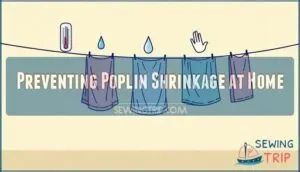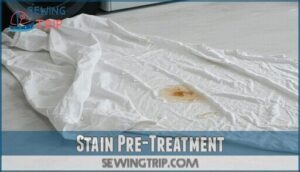This site is supported by our readers. We may earn a commission, at no cost to you, if you purchase through links.

Heat’s your biggest enemy—whether from hot water or high dryer temperatures. You can prevent most shrinkage by washing in cold water, using gentle cycles, and air drying when possible. If you must use the dryer, stick to low heat settings.
The key is understanding your fabric’s fiber makeup before tossing it in the wash. Smart care keeps your favorite poplin pieces fitting perfectly, and there are specific techniques that make all the difference.
Table Of Contents
Key Takeaways
- You’ll experience 3-4.5% shrinkage with cotton poplin after the first wash, while polyester blends resist shrinkage much better with less than 1% change.
- Heat’s your main enemy—hot water and high dryer temperatures cause cotton fibers to contract, so you should stick to cold water washing and air drying when possible.
- You can prevent most shrinkage by using gentle cycles, mild detergent, and low heat settings if you must use the dryer instead of air drying.
- Pre-shrinking your poplin fabric before sewing eliminates future surprises and ensures your finished garments maintain their intended fit.
Does Poplin Shrink When Washed?
You’ll find that poplin fabric does shrink when washed, with cotton varieties showing the most noticeable changes.
Expect around 3% to 4.5% shrinkage depending on your fabric’s fiber content and how you wash it.
Cotton Vs. Polyester Poplin Shrinkage
When comparing fabric blend composition, cotton poplin shrinks considerably more than polyester poplin. Cotton poplin usually shrinks 3-5% after washing, while polyester poplin remains stable with less than 1% shrinkage.
The fiber content analysis reveals polyester’s molecular structure resists shrinkage better than cotton’s hydrophilic fibers.
Material durability differs too – weave density effects help both types, but preventing shrinkage requires understanding each fabric’s unique shrinkage factors before laundering. To minimize shrinkage, it’s vital to follow the care label instructions for the specific type of poplin fabric being used.
Typical Shrinkage Percentages
When considering poplin fabric shrinkage, you’re looking at typical shrinkage rates between 3% and 4.5% after the first wash. Cotton content plays a major role here – 100% cotton poplin shrinks more than material blends with polyester.
The fabric density and weave patterns of poplin help minimize shrinkage compared to looser weaves, but preventing shrinkage still requires proper care techniques. To maintain the quality of poplin fabric, following proper washing instructions is vital to prevent damage and shrinkage.
How Fiber Quality Affects Shrinking
Understanding fiber quality helps predict how your poplin fabric will behave during washing. High-quality, long-staple cotton fibers in cotton poplin shrink less than cheaper, short-staple varieties. Synthetic effects from polyester blends reduce overall shrinkage potential.
Weave density also matters—tighter weaves usually shrink more when washed. Material selection impacts your fabric’s durability and dimensional stability over time.
What Causes Poplin Fabric to Shrink?
Understanding what triggers poplin shrinkage helps you protect your favorite garments from unwanted size changes. Heat from hot water and high dryer temperatures causes the cotton fibers in poplin to contract, while aggressive washing cycles can stress the fabric’s tight weave structure.
Heat from hot water and aggressive washing cycles causes poplin’s cotton fibers to contract and shrink
Heat and Water Temperature
Heat and water temperature are your biggest enemies when washing poplin fabric. Hot water breaks down cotton fibers, causing them to contract and shrink when washed.
Here’s how thermal care affects fabric shrinking:
- Cold Water (30°F-60°F): Minimal shrinkage, preserves fabric integrity
- Warm Water (90°F-110°F): Moderate risk, acceptable for most poplin
- Hot Water (130°F+): Maximum shrinkage potential, avoid with cotton poplin
Higher heat settings during washing methods accelerate fiber contraction, making hot tumble drying equally problematic for maintaining your garment’s original size.
Washing and Drying Methods
Your washing machine and dryer choices dramatically impact poplin’s shrinkage potential. When washing poplin fabric, aggressive cycles create unnecessary stress on fibers, leading to unwanted shrinkage. Gentle detergent combined with delicate wash settings helps maintain fabric integrity.
| Washing Method | Shrinkage Risk |
|---|---|
| Gentle cycle + cold water | Low |
| Normal cycle + warm water | Medium |
| Heavy duty + hot water | High |
| Hand washing | Minimal |
Drying techniques matter equally—high heat settings force fibers to contract rapidly. Air drying offers excellent shrinkage control, while low-heat tumble drying provides convenience without compromising fabric finishing. Preshrinking poplin before sewing eliminates future surprises.
Fabric Composition Factors
Your fabric composition determines exactly how much cotton poplin fabric will shrink. Different fiber blends react uniquely to water and heat, making textile science vital for predicting shrinkage behavior.
Here’s what affects shrinkage in fabric composition:
- 100% cotton fibers – Experience maximum shrinkage (3-5%)
- Cotton-polyester blends – Show reduced shrinkage due to synthetic stability
- Fiber quality variations – Premium long-staple cotton shrinks less than short fibers
- Material mixing ratios – Higher cotton content equals more potential shrinkage
Weave patterns also matter, but your fabric’s base materials hold the biggest influence over dimensional changes.
How to Wash Poplin Fabric Properly
You’ll protect your poplin investment by following proper washing techniques that prevent unnecessary shrinkage and fabric damage. Start by sorting your poplin items by color and fabric weight, then select a gentle cycle with mild detergent to maintain the fabric’s crisp texture and durability.
Sorting by Color and Fabric Type
Before tossing your poplin into the washing machine, take a moment to sort your laundry properly. Color coding prevents disasters – nobody wants their white cotton poplin fabric turning pink from a rogue red sock. Separate darks, lights, and whites into distinct piles.
Next comes fabric sorting, which matters just as much. Group similar materials together since different fabrics have varying washing needs. Check each care label for specific instructions about washing poplin fabric. Heavy denim shouldn’t share space with delicate poplin pieces that might shrink when washed.
This simple laundry tip saves you from shrinkage headaches and keeps your garments looking fresh. Smart washing guide habits start with proper organization.
Choosing Detergents and Cycles
Smart detergent selection makes all the difference when washing poplin fabric. Your care label holds the key to choosing the right approach. Always check whether your poplin is machine washable before diving in. Gentle cleaning works best with mild detergent formulas that won’t break down the fibers.
Here’s your washing methods playbook:
- Use gentle detergent without bleach or fabric softeners
- Select delicate or gentle cycle options for blended poplin
- Cold water protects both cotton and polyester fibers
- Skip harsh chemicals that can weaken the tight weave
- Pre-treat stains before the main wash cycle
The right cycle options depend on your fabric care needs. Cotton poplin works well with normal cycles, while polyester blends prefer gentler treatment. When washing poplin fabric, remember that proper detergent selection prevents damage and maintains that crisp texture you love.
Preventing Poplin Shrinkage at Home
You can protect your poplin garments from shrinkage by following three simple techniques that target the main causes of fiber contraction.
These methods focus on controlling temperature, moisture, and mechanical stress during washing and drying processes.
Washing in Cool or Lukewarm Water
Temperature matters more than you think when washing poplin fabric. Cold water benefits include minimal shrinkage risk, while lukewarm wash techniques offer better cleaning power without the harsh effects.
Water temperature control becomes your best defense against unwanted shrinking. Use gentle detergent with either option, but remember that poplin can shrink when washed in hot water.
Cold water preserves fabric integrity while lukewarm provides effective cleaning.
Air Drying Vs. Tumble Drying
When choosing between drying methods, air drying emerges as your best defense against fabric shrinkage. Heat settings in tumble-dried cycles can cause poplin to shrink when washed, while gentle air-dry methods preserve original dimensions.
High heat transforms fabric care into a gamble—you’ll avoid unwanted shrinkage by skipping the dryer. These laundry tips protect your investment in quality washing poplin fabric pieces.
Pre-shrinking Poplin Before Sewing
Before diving into your sewing project, consider pre-shrinking your poplin fabric through proper fabric preparation. Wash the material using your planned care routine, then air dry completely. This shrinkage prevention technique stabilizes the fibers and prevents unwanted surprises later.
When washing poplin fabric beforehand, you’re basically giving it a "dress rehearsal" before the main event. This sewing technique ensures your finished garment maintains its intended fit, especially important with poplin blends that may shrink when washed differently than expected.
Is Poplin Machine Washable?
You’ll be happy to know that poplin manages machine washing quite well, making it a practical choice for busy lifestyles.
The key is using the right settings and understanding how your specific poplin blend reacts to different wash cycles.
Recommended Machine Settings
When your washing machine becomes your poplin’s best friend, getting the settings right makes all the difference. You’ll want to use gentle or delicate washing cycles to protect the fabric’s tight weave from aggressive agitation. Most modern machines offer fabric settings specifically designed for cotton blends, which work perfectly for poplin garments.
Here are the key machine settings for washing poplin:
- Use gentle or delicate washing cycles to minimize fabric stress
- Set spin speeds to low or medium (800-1000 RPM maximum)
- Choose cold to warm water temperature controls (30-40°C/86-104°F)
- Select cotton or mixed fabric settings when available
- Enable extra rinse cycles to remove all detergent residue
Your machine’s drying modes should stay on low heat or air-dry settings since high temperatures cause unnecessary shrinkage.
Tips for Delicate or Blended Poplin
Blended poplin requires extra attention since different fibers react differently to washing. Cotton-polyester blends need cooler water temperatures than pure cotton varieties to prevent uneven shrinkage between fiber types.
You’ll want to use a gentle cycle with mild detergent to protect delicate finishing treatments that give poplin its smooth texture. For rayon or silk blends, consider hand washing or using your machine’s delicate setting.
Always check care instructions before washing – some blended poplins need special textile treatment to maintain their fabric blending integrity. When in doubt, test wash a small hidden area first to see how your specific blend responds.
Caring for Cotton Poplin Clothing
You’ll want to master a few key techniques to keep your cotton poplin looking crisp and professional for years to come.
These essential care practices will help you tackle wrinkles, handle stains effectively, and store your garments properly between wears.
Ironing and Wrinkle Removal
Cotton poplin responds beautifully to proper ironing techniques. Set your iron to medium heat and use steam for best results.
Here are three proven methods for wrinkle-free poplin:
- Iron while damp – Tackle wrinkles before fabric fully dries from tumble dried loads
- Steam vertically – Hang garments and steam to prevent shrink risk from direct heat
- Press with fabric relaxation – Use gentle pressure and let steam penetrate fibers naturally
These steaming methods deliver smooth finishing without damaging your poplin’s crisp texture.
Stain Pre-Treatment
Tackling stains quickly saves your poplin fabric from permanent damage. Check the care label first, then pretreat stains with a gentle stain removal solution before washing. Blot—don’t rub—to avoid spreading the mess.
For spot cleaning, use cold water and mild detergent on fresh spills. These laundry tips protect your poplin’s crisp texture and prevent fabric protection headaches later.
Proper Storage Tips
Proper storage prevents unnecessary wrinkles and helps your poplin garments maintain their shape between wears. Follow these storage guidelines to keep your cotton poplin looking fresh:
- Folded Storage: Fold along natural seam lines to minimize creasing
- Hanging Tips: Use padded hangers for structured items like blazers
- Closet Organization: Allow adequate spacing between garments for air circulation
- Fabric Folding: Store heavier items on lower shelves to prevent crushing
- Shelf Management: Keep poplin away from direct sunlight and humidity
Always check care instructions before storing long-term.
Why Choose Poplin for Your Wardrobe?
You’ll appreciate poplin’s perfect balance of durability and easy care that makes it ideal for busy lifestyles.
This adaptable fabric offers crisp texture and breathable comfort while requiring minimal maintenance compared to other dress shirt materials.
Benefits of Poplin Fabric
Beyond proper care, poplin offers compelling advantages that make it a wardrobe staple. Its Fabric Comfort and Breathability keep you cool during summer months, while Seasonal Versatility transitions smoothly into fall layering. The Crisp Appearance maintains professional polish, and Texture Variety suits both casual and formal settings. Fashion Practicality shines through its Easy to Care For nature.
| Benefit | Summer | Year-Round |
|---|---|---|
| Fabric Comfort | Soft against skin | Consistent feel |
| Breathability | Excellent airflow | Temperature regulation |
| Crisp Appearance | Fresh look | Professional polish |
| Seasonal Versatility | Lightweight layers | Adaptable styling |
| Fashion Practicality | Low maintenance | Reliable choice |
Durability and Versatility
Strength and durability make poplin fabric a smart investment for your wardrobe. This resilient material withstands regular washing while maintaining its crisp appearance and breathable comfort across seasons.
Here’s why poplin fabric delivers remarkable versatility:
- Seasonal wear adaptability – moves smoothly from summer shirts to layered winter looks
- Flexible styling options – works for both casual and professional garments
- Garment construction reliability – holds shape and structure through repeated wear
- Fabric longevity – cotton poplin fabric resists wear and tear for years of use
Low Maintenance Requirements
You’ll appreciate poplin’s low maintenance needs, making it perfect for everyday wear. This machine washable fabric requires minimal effort – just check the care label and wash poplin in your regular cycle.
Easy care tips include simple washing with gentle detergent and quick ironing when needed. The fabric durability means fewer replacements, while shrinkage prevention comes naturally with proper care.
Easy to care for poplin saves you time and hassle.
Frequently Asked Questions (FAQs)
What are the different materials used to make poplin fabric?
You’ll find poplin made from cotton, polyester, rayon, silk, and wool. Cotton and polyester are most common. Cotton offers softness and breathability, while polyester provides wrinkle resistance and durability.
Does the weave style of poplin fabric affect its shrinkage?
Poplin’s tight plain weave actually helps reduce shrinkage compared to looser weaves.
The dense construction creates stability, making the fabric less likely to shift and shrink during washing than fabrics with open weaves.
What are the common uses for poplin fabric?
Over 75% of dress shirts worldwide contain poplin fabric. You’ll find this adaptable material in button-down shirts, blouses, dresses, skirts, and even home décor like curtains and bedding due to its crisp texture and breathability.
How can I prevent poplin fabric from shrinking during washing?
You’ll want to wash in cool water and air-dry your fabric. Skip the hot water and high heat settings—they’re shrinkage culprits.
Pre-wash before sewing to handle any initial shrinking upfront.
Can you unshrink poplin after washing?
You can’t teach an old dog new tricks, but you can try unshrinking poplin by soaking it in lukewarm water mixed with hair conditioner, then gently stretching it back into shape. Air-dry flat afterward.
Does poplin shrink more than cotton?
Generally, you’ll find poplin doesn’t shrink more than regular cotton. Both fabrics share similar shrinkage rates of 3-5%, but poplin’s tight weave structure actually helps maintain its shape better than loose cotton weaves.
Will poplin shrink in cold water?
Cold water won’t completely prevent poplin shrinkage, but it’ll minimize it substantially. You’ll still see about 1-2% shrinkage versus 3-5% in hot water. Air-drying helps reduce shrinkage even more.
How long does poplin take to dry?
Like watching paint dry, poplin’s drying dance unfolds predictably. Your fabric’s thickness determines the timeline.
Air-drying takes 2-4 hours for lightweight pieces, while machine drying runs 30-45 minutes on low heat.
Does poplin wrinkle easily when wet?
Yes, poplin does wrinkle when wet. Cotton-based poplin can wrinkle when wet, especially the 100% cotton versions. You’ll notice it most after washing or if caught in rain.
Conclusion
Mastering poplin care is like learning to dance with your fabric—once you know the steps, you’ll never miss a beat. Understanding does poplin shrink helps you protect your investment pieces for years to come.
Cotton poplin will shrink if you’re careless with heat, but proper washing techniques keep everything fitting perfectly. Stick to cold water, gentle cycles, and air drying when possible. Your poplin garments will thank you with lasting comfort and style.















